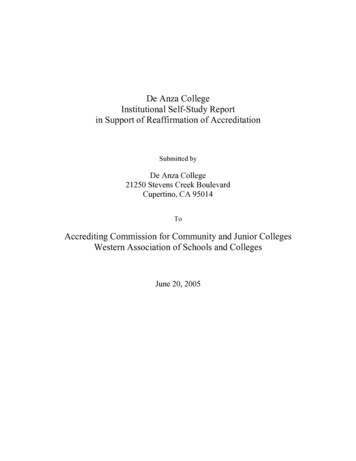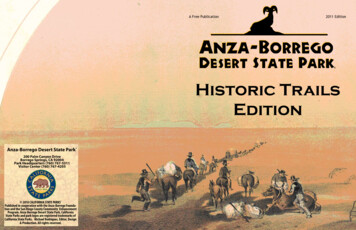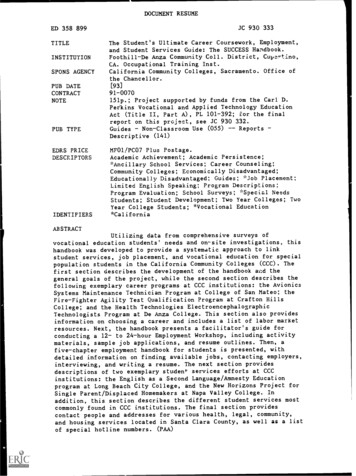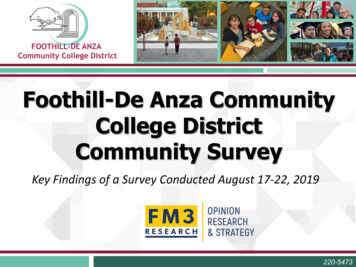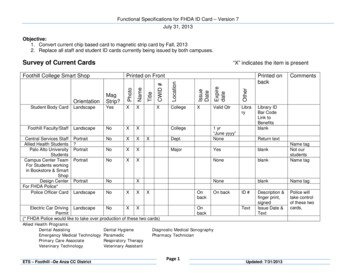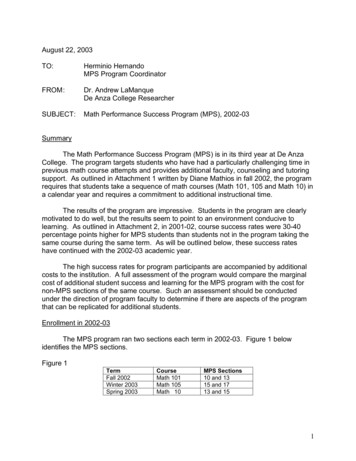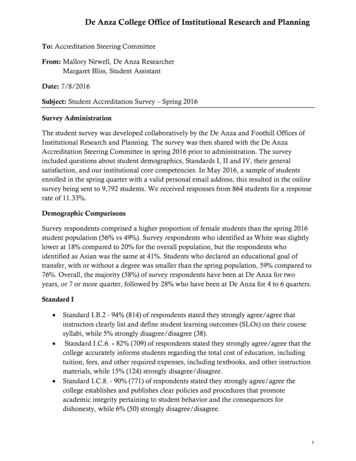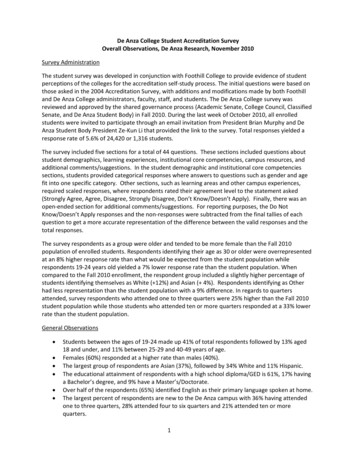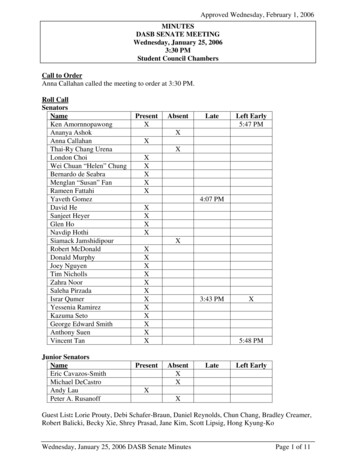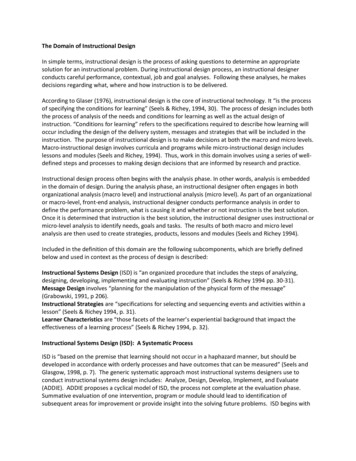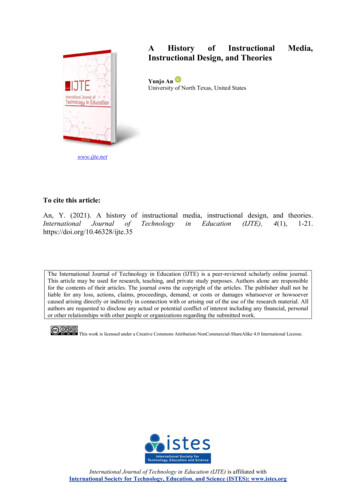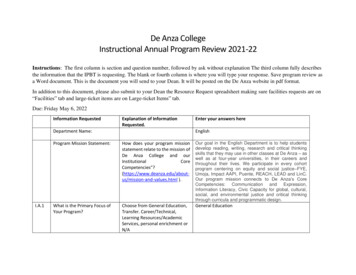
Transcription
De Anza CollegeInstructional Annual Program Review 2021-22Instructions: The first column is section and question number, followed by ask without explanation The third column fully describesthe information that the IPBT is requesting. The blank or fourth column is where you will type your response. Save program review asa Word document. This is the document you will send to your Dean. It will be posted on the De Anza website in pdf format.In addition to this document, please also submit to your Dean the Resource Request spreadsheet making sure facilities requests are on“Facilities” tab and large-ticket items are on Large-ticket Items” tab.Due: Friday May 6, 2022Information RequestedExplanation of InformationRequested.Department Name:I.A.1Enter your answers hereEnglishProgram Mission Statement:How does your program missionstatement relate to the mission ofDe Anza College and eanza.edu/aboutus/mission-and-values.html ).Our goal in the English Department is to help studentsdevelop reading, writing, research and critical thinkingskills that they may use in other classes at De Anza – aswell as at four-year universities, in their careers andthroughout their lives. We participate in every cohortprogram centering on equity and social justice–FYE,Umoja, Impact AAPI, Puente, REACH, LEAD and LinC.Our program mission connects to De Anza’s CoreCompetencies: Communication and Expression,Information Literacy, Civic Capacity for global, cultural,social, and environmental justice and critical thinkingthrough curricula and programmatic design.What is the Primary Focus ofYour Program?Choose from General Education,Transfer. Career/Technical,Learning Resources/AcademicServices, personal enrichment orN/AGeneral Education
I.A.2Choose a Secondary Focus ofYour Program.I.B.1# Certificates of AchievementAwardedI.B.2# Certificates of AchievementAdvanced Awarded:I.B.3# ADTs (Associates Degrees forTransfer) AwardedChoose from General Education,Transfer. Career/Technical,Learning Resources/AcademicServices, personal enrichment orN/AState the number of Certificatesof Achievement awarded duringthe 2020-21 academic year.Please refer to:https://www.deanza.edu/ir/AwardsbyDivision.html . If you do notoffer Certificates of Achievementplease state “none offered”.State the number of Certificatesof Achievement - Advancedawarded during 2020-21academic year. Please refer tohttps://www.deanza.edu/ir/AwardsbyDivision.html If you do notoffer Certificates ofAchievement” please state “noneoffered”.State the number of AssociateDegree Transfer awarded by yourdepartment during the 2020-21academic year. Please refer tohttps://www.deanza.edu/ir/AwardsbyDivision.html . If you do notoffer Associate Degree Transfer,please state “none offered”.TransferNone offeredNone offered15
I.B.4# AA and/or AS DegreesAwarded:I.B.5.Trends in # Total AwardsI.B.6.Strategies to Increase AwardsI.C.1CTE Programs: Review ofPerkins Core Indicator and SWPOutcomes MetricsState the number of Associate ofArts or Associate of Sciencedegrees awarded during the2020-21 academic year. Pleaserefer tohttps://www.deanza.edu/ir/AwardsbyDivision.html . If you do notoffer Associate of Arts orAssociate of Science Degree,please state “none offered”.If applicable to your program, hastotal number of certificates anddegrees increased, decreased orstayed the same? What thoughtsdo you have on these changes?What strategies (1, 2, 3. . . .) doesyour department have in place toensure students are obtainingawards when it is applicable totheir educational goal? (e.g.Outreach, In-reach, graduationworkshops, collaborations withother offices, etc.)Review the most recent PerkinsCore Indicator and SWPOutcomes Metrics data for yourprogram(s). Cite plannedinterventions and activities toenhance student and programoutcomes.15The trend in our number of degrees awarded is aboutthe same for the last four years. We hold regularEnglish Majors events each year, participate in VillageActivities, including working with the HonorsCommittee to help all students with UC transfer essays.We will be working with the math department to offercombined math and English literacy certificates whenwe are able to develop new courses in e.aspx
I.C.2CTE Programs: Labor MarketDemand and Industry Trends:I.D.1Academic Services andLearning Resources: # FacultyServedPerkins Core Indicator Reportsprovided by Margaret Bdzil. CalPASS Launchboard SWP me.aspxReview and summarize statewideand regional labor market (LMI)data for occupations that areclosely aligned with yourprogram. Cite current industrytrends. Provide an overview ofyour program advisorycommittee's recommendationsrelating to existing and newcourse and certificate/degreeofferings. Cite additional datawhen applicable.California EDD LMI taanalysis/areaselection.asp?tablename occprjOnly for programs that serve staffor students in a capacity otherthan traditional instruction, e.g.tutorial support, service learning,etc. State number of facultyserved per year (Fall, Winter andSpring): Provide number fromprevious year, and # increase ordecrease. To the extent possible,specify what data you used toarrive at this number.n/an/a
I.D.2Academic Services andLearning Resources: #Students ServedI.D.3Academic Services andLearning Resources: # StaffServedI.E.1Full Time Faculty (FTEF)I.E.2# Student EmployeesOnly for programs that serve staffor students in a capacity otherthan traditional instruction, e.g.tutorial support, service learning,etc. State number of studentsserved per year (Fall, Winter andSpring): Provide number fromprevious year APRU, and #increase or decrease. To theextent possible, specify what datayou used to arrive at this number.Only for programs that serve staffor students in a capacity otherthan traditional instruction, e.g.tutorial support, service learning,etc. State number of staff servedper year (Fall, Winter and Spring):Provide number from previousyear APRU, and # increase ordecrease. To the extent possible,specify what data you used toarrive at this number.For ALL programs: State thenumber of FTEF assigned to yourdepartment/program. Refer toyour program review data 21/index.html .If applicable to your program,state number of studentemployees and if there were anychanges between number thisacademic year and the previoustwo academic years.n/an/a44.0None
I.E.3Full Time Load as a %I.E.4# Staff EmployeesI.E.5Changes inEmployees/ResourcesEnrollmentState the percentage of coursestaught by full-time faculty(exclude overload). Refer to yourprogram review data 21/index.html oraccess within the program reviewtool.If applicable to your program,state number of staff employeesand if there were any changes.ONLY report the number of staffthat directly serve your program.Deans will make a reportregarding staff serving multipleprograms.Briefly describe how any increaseor decrease resources/employees(exclude teaching faculty) hasimpacted your program. Whatstrategies does your programhave in place to ensure studentsare being supported and able toreach their full capacity whenfaced with these changes andchallenges? (e.g. Mentors,embedded tutors, extended labhours, instructional support, noncredit support, etc.)For 2020-21English 38.6%Literature 72%Our full-time load is still substantially short of the CCCgoal of 75% FT to 25% PT in English Writing.Nonen/aThe English department collaborates with the EPScounselors to support students who place into English1A bundle and EWRT 1AS & T). The English departmentalso works with the Writing and Reading Center tooffer many options for students to fulfill needs fortutoring and improving reading and writing skillsthrough Instructional Support.
II.AEnrollment TrendsWhat changes in enrollment haveyou seen in the last three years?Refer ndex.html oraccess within the program reviewtool. You do not need to listenrollments; rather reflect onenrollment trends. Whatstrategies does your departmenthave in place to increase ormaintain current enrollmenttrends?For the EWRT courses, enrollment generally declinedover the past three years. However, given the factorsof the pandemic, which began in March 2020, and thesurge of fake students in 2020-2021, it is difficult toknow whether the decline represents a response to theimmediate circumstances of the pandemic, whether itis a result of the elimination of developmental writingcourses, or whether it represents the larger trend ofdeclining enrollment that the college has experienced.The numbers of the English department are greaterthan the College’s 5-year average, which suggests thatother factors may be affecting EWRT enrollment.The English department plays a prominent role inseveral student cohort programs to offer writingclasses specially designed for those cohorts: REACH,UMOJA, PUENTE, FYE, LinC, Impact AAPI, and LEAD.The department carefully monitors its course offerings,adjusting the schedule to meet student demand. Sincenearly every student takes EWRT 1A, possible growthareas are in increasing EWRT 1B enrollments, ELITcourses and EWRT 2 through stand alone and cohortofferings.For the ELIT courses, enrollment has increased slightly,and while the overall 5 year average shows a decline inenrollment, the decline is less than the all-Collegedecline.
The ELIT increase reflects the improvement in offeringsto best meet students’ needs, in terms of specificcourses and scheduling. Also, the Literature Committeehas begun to work with student cohort programs oncampus.II.B.Enrollment Trends fordisproportionately impactedstudent groupsUsing the program review datatool, what is the enrollment ofAfrican American, Latinx, Filipinx,and Pacific Islander students as apercentage of your entireprogram compared to otherstudent groups in campus-widepercentages? You do not need tolist enrollments, but ratherreflect on what the trends looklike. Link to equity plan andstrategic plans1. What could becontributing to thedifferences?2. What strategies doesyour department have inplace to increase ormaintain enrollment ofthese student groups?Are there other trends that yousee when drilling into the datathat may be important toexplore?In general, for all of the groups listed, the enrollmenthas remained stable in both the EWRT and ELITcourses. The only difference has been a slight increasein Latinx students for the ELIT courses.In terms of proportionate enrollment, compared tocollege wide, the enrollments by ethnicity are roughlythe same for both the EWRT and ELIT courses. For theEWRT courses, about 3% fewer Asian students enroll,but 5% more Latinx students take EWRT courses.For ELIT courses, about 12% fewer Asian students takeELIT courses, but 6% more Latinx students, and 6%more White students do.These numbers may reflect the department’s efforts towork with the student cohort programs, for theincreasing Latinx enrollment, such as Puente. Thedepartment has been working with various studentcohort programs, and plans to expand to includeUmoja.
One other change has been an increase in the femalestudents to male students (from 46:54 to 49:50), whichis not fully explained by changes in the “non-binary”and “not reported” categories. However, the currentratio of male to female students is now similar to thecollege-wide data. Perhaps this has something to dowith the changes imposed by AB 705 to now placeevery student into college-level English courses.II.C.Overall Success RateWhat changes in student successrates have you seen in the lastthree years? You do not need tolist success rates, rather reflecton trends in success rates.1. What could be factorsthat influence successrates? Please refer dex.html2. What strategies doesyour department havein place to increase ormaintain currentsuccess rates?Overall, the EWRT success rates have declined slightly,from 2019-2022, by 3%. The non-success rates havestayed roughly the same, and the withdrawal ratesincreased slightly, by 2%. These figures correspondwith the all-college success rates, which increased byabout that same amount.We suspect that the greatest influence is thepandemic, as many of our students were eitheressential workers who had to work to support theirfamilies, or contracted Covid-19, or had family who fellill. The intense nature of composition courses meansthat when students fall behind, it is generally difficultfor them to catch up.The department relies on the EPS counselors forstudents in the Stretch and Bundle EWRT 1A courses;faculty are beginning to use the Early Alert System.Our PAGE (Preparation, Assistance, Growth and Equity)committee gathers bimonthly to share best practices,student engagement and retention strategies.
The department has been using the Writing andReading Center, particularly the tutoring andworkshops for all the composition classes. We have arequirement for our Bundle and Stretch EWRT 1Astudents to use the WRC/Tutoring Center servicesthroughout the quarter. Students report that theseexperiences were helpful. The department alsoinstituted a Stretch to Success model this year, toencourage students to successfully complete theStretch sequence.The department continues to offer sections of EWRT1A, EWRT 2, and ELIT as part of the student cohortprograms for the following programs, which increasedthe success rates for our targeted populations: ImpactAAPI, REACH, UMOJA, PUENTE, FYE, and LEAD. Thedepartment offers a yearly GE program for studentswho enroll in EWRT 1A and content-area coursesthrough the LinC program. These initiatives serve tobuild community and support student needs.The department helped prepare a mental healthworkshop for faculty at the fall division meetingbringing in student voices and faculty expertise on theimportance of integrating mental health and wellnessin our classes.All these initiatives serve to support student retentionand success in English, Literature and Creative Writingcourses.
II.D.Success, Non-Success andWithdraw Rates fordisproportionately impactedstudent groupsUsing the DisproportionateImpact Tool within the ProgramReview Tool explore differencesin success rates by ethnicity,gender and special studentpopulations (foster youth,individuals with disabilities,Veterans and low incomestudents). Of the rows that arehighlighted (which indicate thereare disproportionate impacts forthat group):1. What differences doyou see in successfulcourse completionrates?2. What are yourthoughts on thesedifferences?What strategies might be helpfulin closing gaps in successfulcourse completion?For the Disproportionate Impact (DI), three main ethnicgroups show a difference in success rates resulting in aDI. They are: African American, Latinx, and PacificIslander. A fourth group, Low Income students, alsoshows a disproportionate impact. But we do not knowif there is overlap between the Low Income and theethnic groups in terms of student populations of thoseDI groups.The success rates for African American and Latinxstudents is not significantly different from the collegewide success rates. Students of Pacific Islanderbackground do have a noticeably lower success rate inEnglish courses. This points to the need for highlightingthis cultural group through culturally responsiveteaching practices and curricula along with directingmore Pacific Islander students to the Impact AAPIprogram. We also see a higher withdrawal rate forAfrican American students; the department will workon early intervention and teaming with campus-wideinitiatives, such as the Men of Color Community andthe Office of Equity and Engagement.We see improved success rates for Filipinx students.The English department has already implementedcohort programs aimed at those ethnic groups, such asUmoja, Puente, LEAD, and Impact AAPI sections ofEWRT 1A and EWRT 2. The students participating inthose cohort programs have higher success rates thancomparable students in the regular programs.
Supporting low income students is more challenging toaddress, since it is not clear what students in thatcategory need: equipment for learning online, financialassistance (separate from financial aid) for expensesbeyond being a student. This points to a need for EPScounselors and educational workshops for faculty onhow to support low income students through OER(lowering book fees) and College Promise.II.E.Changes Imposed byInternal/External RegulationsAddress program changesimplemented as a response tochanges in College/District policy,state laws,division/department/programlevel requirements or externalagencies regulations? How didthe change(s) affect yourprogram? (e.g. any curriculum,reorganization of program AB705, noncredit curriculum, loss ofpersonnel, etc.)AB 705 implementation continues to impact our abilityto offer courses to meet the needs of our students. Asof Fall 2022, we can no longer offer Stretch EWRT 1AS& T due to impossible-to-reach throughput datacomparisons.While the college supports offering a few non-creditcourses to meet the needs of students who desire skillpractice before enrolling in transfer-level English, weare not able to develop and offer new non-creditcourses until Fall 2024 (when eLuman will be fullyoperational). In the meantime, we are working on thefollowing initiatives in response to losing EWRT 1AS &T:1. the creation of free modules for students toimprove their skills in collaboration with theWriting and Reading Center.2. a pilot learning community program linkingone or two sections of EWRT 1A / LART 250and a counseling course for students with GPAsof 1.9 and below.
We also need to track non-success (students whodropped/withdrew both before and after census aswell as did not receive a passing grade on theirtranscripts) in transfer level EWRT 1A course options,to ensure that the equity gap in students who aren’tsucceeding does not increase.The pandemic created renewed interest, resilientchange, and new needs: increasing numbers ofstudents benefit psychologically throughengagement in creative writing and artscommunities. Students have been needing creativearts to deal with stresses of the pandemic. Ourprograms are good for making connections, evenin Zoom, and building communities, andaddressing mental health.Our Red Wheelbarrow magazine program wasable to adapt to Canvas, Zoom, and webpublishing—including creating journals both asdownloadable PDFs and as printed books, thelatter with ongoing DASG support)EquityIn order to meet the goals withinour State EquityPlan, InstitutionalMetrics, and Educational MasterPlan, the following section asksyou to reflect on questionsfocused on student equity to helpinform our goals.
III.A.Equity Plans for groups otherthan the acknowledgeddisproportionately impactedgroupsAre there other groups ofstudents besides theacknowledged disproportionatelyimpacted groups of AfricanAmerican, Latinx, Filipinx, andPacific Islander students thatyour department intentionallyfocused support for.Our department plays a prominent role in programsthat serve DSPS and first-generation students. In2021/22 we created the “Stretch to Success” Programfor students (with low HS GPS scores) who placed intothe two quarter EWRT 1AS and EWRT 1AT sequence. Incollaboration with the EPS counselors, we offered twolearning communities. Unfortunately, the State ofCalifornia is using data metrics to prohibit collegesfrom offering support courses and multi term offerings.We are now pivoting to a Bundle (EWRT 1A LART250) program for these same students: Pilot AY2022/23.The English Department successfully integratescounseling and English writing courses for Athletes inthe REACH program.The English Department hopes to work with the FacultyCoordinator of the Women, Gender, Sexuality Centerto offer a course for LGBTQ students with culturallyresponsive curricula.Our Literary Magazine has thrived during pandemic andis an important symbol of the resiliency of creativity forstudents interested in creative writing. The nationaledition of Red Wheelbarrow maintains nationalrecognition as a top South Bay journal, including in thecurrent (coming May/ June) issue of Poets & Writersmagazine.The English Department serves GE students in the LinCprogram, integrating with other disciplines acrosscampus to inspire deeper learning and contentconnections. This program supports communitybuilding for students even during the Pandemic.
The English Department will work with VIDA to offerReading and English courses in their Social JusticeStudies major which serves many reentry students.III.B.Program SuccessDescribe any events/programchanges/successes that youwould like to share relative toyour equity efforts?CSA: The English Department continues to providesupplemental learning that the WRC uses in the CSAofferings to support our underrepresented students.We have an excellent collaborative relationship withthe WRC facilitators.EPS: We have a strong relationship with the EPScounselors; we continue to build pilot programs toserve our students most in need of support: Stretch toSuccess (2021/22) and plans for Bundle Up! (2022/23).PAGE: Our PAGE committee members meet regularlyto share curricula and best practices, respond to AB705 and AB 1705 regulations, including communicatingwith the Chancellor’s Office and the offices ofAssessment and Institutional Research at De Anza tocontinuously serve our students and improve ourequity efforts.Portfolio: Faculty participate in a successful portfolioprocess for Stretch 1A and Bundle 1A courses thathelps support students through holistic assessmentsand faculty engagement.
Cohort Programs: The English department is involvedin every cohort program on campus that serves theneeds of our students in the targeted groups. Ourfaculty dedicate their professions to teaching practicesand curricula that are equity-based and thematicallyconnected to social justice.Literary Magazine: Our award-winning student writerscontinue to win prize money and recognition nationally aswell through the annual League for Innovation LiteraryCompetition. We worked with the college in 2021 to includeour first ever graduation poet, Sara Robertson, now atBerkeley. She had taken three of our creative writingcourses, including Red Wheelbarrow, and mentionedRed Wheelbarrow in her remarks. New recruitmenttechniques fill the classes. Set a record this quarter forEWRT 68 enrollment (over 30)III.C.Equity Planning and SupportHas equity work generated anyneed for resources? If so, what isyour request? Includestaff/position needs.Yes!Cohort Programs:
Puente is a model for other cohort programs withembedded counseling and funding. De Anza hasrecognized the need for counseling and tutors withinthe cohort programs. Students must be engagedpersonally to learn and enjoy the support of faculty,counselors, and mentors/tutors within a program.Many of our faculty have dual roles: they work inprograms within the Equity and Engagement Divisionthat require extra time and resources and they teachstand-alone courses to make their load. Each year it isa challenge to staff the multiple student equity cohortsthat De Anza offers which all include English courses.This work requires full time faculty participation, butwe need new English faculty positions because it isunfair to ask part time faculty to participate regularly inteaching these cohort courses since they requirecoordination, additional meetings, and new curricula.This is going to be vital in AY 2022/23 when we willincrease our cohort and learning community offeringsto fulfill our goals in the SIP grant.We request 1) an additional hire for staffing purposes2) a revision of the additional pay guidelines that havenot changed for over 15 years.Portfolio:The Portfolio is an excellent holistic assessment ofstudent writing that includes metacognition andreflects student agency. As we increase our EWRT 1A /LART 250 offerings (with the elimination of Stretch 1Adue to AB 705) and consider adding EWRT 1A to theprocess, we will need more funding for coordination,training, norming, and departmental workshops.
EPS Cohort Program:As we pivot once again due to AB 705 / 1705regulations, the English Department will coordinatewith EPS to offer a Bundle / Counseling LearningCommunity (supported by LinC). We need to make surethe LinC program can continue to support this programas it will be vital for students who no longer can enrollin prerequisite courses or Stretch EWRT 1A (multiterm).Literary Magazine:The Red Wheelbarrow is a source of pride forthe students who participate in its production:the editors, the contributing authors, and thelocal creative writing community. Seeing one’sname in print, provides students a tangiblememory of their accomplishments. To that end,we ask the administration to purchase 50-100copies of the journal, to ensure the stability ofthe program. The magazines purchased can bedonated back to students and teachers to use inthe classroom, or any number of campus visitorsor VIPs who might need a special gift from ourcampus.
The Red Wheelbarrow strives to include diversevoices and viewpoints of the De Anza studentbody. To enhance our work, we would like tocollaborate with the Office of Equity incelebrating diverse voices on campus in printpublication, exposure through our YouTubechannel (another adaptation and invention ofthe exigencies of the pandemic), and throughjoint editing ventures.During the pandemic, we have imagined ourdivision or our college as a whole helping ussponsor an annual book sales event orsubscription drive to help stabilize our funding.III.D.Departmental Equity Planningand Progress Identify which of the followingresources you need? How wouldthe resource help?Professional Development – whatareas?Enhanced support for studentsDepartmental CollaborationsBest Practices Coaching/ConsultationFaculty in the English department participate in severaltraining opportunities that enhance their efforts inequity through the Office of Equity. Our own facultycoordinate the Women, Gender, Sexuality Center(Chesa Caparas and Roseanne Quinn), so we have richexpertise when it comes to equity planning andprogress). Faculty in English hold leadership roles in theVillages which coordinate equity planning and progressfor the entire college.Enhanced support for students in our EWRT 1A LART250 courses could involve the use of tutors andmentors working directly with faculty to serve thestudents.
III.E.Assistance Needed to closeEquity GapAssessment CycleIV.ASLOAC SummaryWould you like assistance withidentifying strategies and/or bestpractices and/or resources tohelp facilitate student success?Navigate tohttps://www.deanza.edu/slo/and click “TracDat is gone” whichwill take you to accordion listingSLO assessments under “StudentLearning Outcomes andAssessments Summaries byDivision:”Describe an accomplishment orenhancement that resulted fromSLO assessment starting withSpring 2020 through end of Spring2022.none neededPortfolio Process: Our department has a robust EWRT1A portfolio process. In 2020, we included the portfolioin EWRT 1AS & T along with EWRT 1A LART 250.Metacognitive awareness is a key aspect of the portfolioand it is also a resource for faculty training, norming,and collaboration. We included stand-alone English 1Ain Fall 2020 - Spring 2021 as a pilot. We assessed theEnglish 1A portfolio process and determined thatincluding the portfolio during the Pandemic waschallenging since we were already losing instruction dueto moving instruction to Canvas. We voted to suspendEWRT 1A stand alone as part of the Portfolio, but we willbring this back to discussion Spring, 2022.
Stretch to Success with EPS: English faculty and EPScounselors worked in collaboration together to servethe needs of our most vulnerable students. Afterworking with Institutional Research to survey studentswho enrolled in EWRT 1AS & T, we created a pilotprogram to address the needs of students with thelowest HS GPS scores. With the support of the Dean ofLanguage Arts, we offered two sections of 1AS & T andCLP 5 followed by EWRT 2 in Spring 2022. We assessedour students after completing EWRT 1AS to determinetheir needs for Winter 2022 (EWRT 1AT).IV.BV.AAssessmentResource RequestsBudget TrendsList the names of the courses inyour department (e.g. CIS 22A)that are planned to be assessedby the conclusion of 2021-22academic year.EWRT 1A LART 250 Bundle Up Program (to beassessed Fall 2022)Over the past five academicyears, describe impact, if any, ofexternal or internal fundingtrends that you might becurrently dealing with ( eg COVIDdemands) upon the programand/or its ability to serve itsstudents.If you don’t work with budget,please ask your Division Dean togive you the information.no changes.EWRT 1A LART 250EWRT 1A stand alone
V.BFunding Impact on EnrollmentTrendsV.C.1Faculty Position(s) NeededV.C.2Justification for FacultyPosition(s):Over the past five academicyears, describe the impact, if any,of external or internal fundingchanges upon the program’senrollment and/or its ability toserve its students. Refer toProgram Review data sheets forenrollment information:Describe each request as:“Replace due to Vacancy”,“Growth”, or if none state “NoneNeeded Unless Vacancy”Do you have assessment dataavailable to justify this requestfor a faculty position? If soprovide the SLO/PLO assessmentdata, reflection, andenhancement that support thisneed. If not, provide other datato support this need.no impact.Two replacements requested due to Vacancy(retirements and resignation).Our data shows that our FTEF is down significantly. In2018-19, we had 52 FTEF. By 2019/20, we had 47 FTEF.This year we have 44 FTEF.The decline in enrollment does not assuage the needfor full-time facul
De Anza College Instructional Annual Program Review 2021-22 Instructions: The first column is section and question number, followed by ask without explanation The third column fully describes the information that the IPBT is requesting. The blank or fourth column is where you will type your response. Save program review as a Word document.
